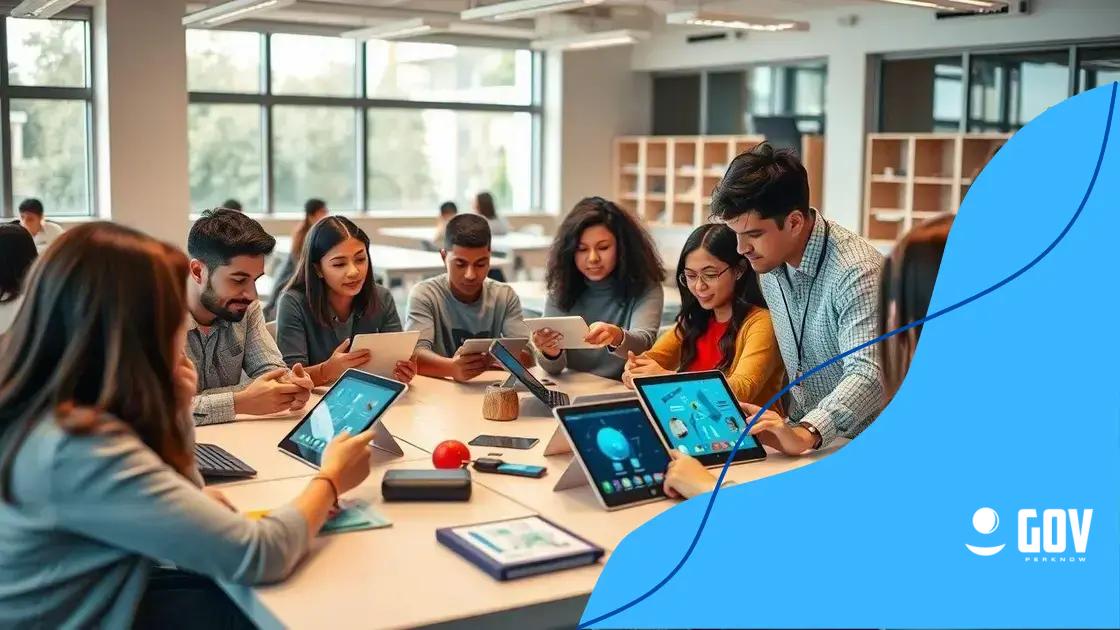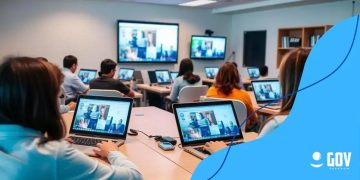AI tutors and the future of personalized learning in K-12 education

AI tutors are transforming K-12 education by providing personalized learning experiences, automating administrative tasks for teachers, and leveraging technology such as virtual reality, enabling students to learn at their own pace and enhancing collaboration.
AI Tutors and the Future of Personalized Learning in K-12 Education are driving a new wave of educational change. With advancements in technology, students are experiencing tailored learning experiences like never before. Have you ever wondered how this impacts both learners and educators?
The role of AI tutors in classrooms
The role of AI tutors in classrooms is becoming increasingly significant as technology enhances educational experiences. AI tutors are designed to provide personalized support, helping students understand complex subjects at their own pace. With tailored feedback, these systems can adapt to various learning styles.
How AI Tutors Enhance Learning
AI tutors leverage advanced algorithms to assess student performance and modify their teaching methods accordingly. This means that they can address individual strengths and weaknesses more efficiently than traditional methods. By analyzing data, AI technology can pinpoint areas where students struggle and offer targeted resources.
Key Benefits of AI Tutors
- Personalized learning experiences for each student
- Instant feedback and support during study sessions
- Increased engagement through interactive learning tools
- Ability to support teachers by managing routine tasks
As a result, educators can focus on higher-level teaching strategies. AI tutors can also help bridge the gap for students who require extra assistance. They can access materials and resources at their convenience, promoting self-directed learning.
Moreover, the integration of AI into classrooms not only assists students but also enhances the teaching experience. Teachers can utilize insights gained from student interactions with AI tutors to tailor their instruction plans. This collaborative approach creates a synergistic environment where technology and human instruction can coexist effectively.
Challenges and Considerations
However, the deployment of AI tutors comes with challenges. It’s essential to ensure that technology is used as a tool for enhancement, not a replacement for human interaction. Some students may still require personal connections that AI cannot provide fully, making it crucial to blend AI support with traditional teaching methods.
In conclusion, the role of AI tutors in classrooms is transformative. By offering personalized support, facilitating increased student engagement, and alleviating teachers’ workloads, these tutors are reshaping education as we know it.
Benefits of personalized learning
Benefits of personalized learning are becoming increasingly clear in today’s educational landscape. By tailoring education to meet each student’s unique needs, personalized learning fosters a more engaging and effective learning experience.
Enhancing Student Engagement
One of the key benefits of personalized learning is that it enhances student engagement. When learners have control over their educational journey, they are more likely to stay interested and involved. This engagement can lead to better academic performance and increased motivation.
Improved Learning Outcomes
- Students achieve higher test scores
- Increased retention of information
- Development of critical thinking skills
- Ability to learn at their own pace
As students progress at their own pace, they do not feel rushed or left behind. This flexible approach not only builds confidence but also allows learners to explore topics in depth. By focusing on what interests them, students can dive deeper into subjects.
Furthermore, personalized learning promotes the development of critical thinking skills. When students tackle challenges appropriate to their skill levels, they learn to analyze and solve problems more effectively. This skill set is essential for success beyond the classroom!
Support for Diverse Learning Styles
Another significant advantage of personalized learning is its ability to support diverse learning styles. Every student is unique, with different ways of processing information. This method allows educators to implement varied instructional strategies catering to visual, auditory, and kinesthetic learners. As a result, students can grasp complex concepts more readily.
Additionally, personalized learning fosters a positive learning environment. Students often feel more comfortable expressing their thoughts and asking questions when they receive tailored guidance. This open communication can build strong relationships between students and educators, further enhancing the educational experience.
How AI is reshaping teacher roles

How AI is reshaping teacher roles is a key topic in modern education. With the rise of AI technology, teachers are finding new ways to enhance student learning and streamline their workload. AI tools help teachers focus on what they do best—engaging and inspiring their students.
Facilitating Administrative Tasks
One major change is how AI assists with administrative tasks. Teachers often spend a lot of time grading assignments and managing class schedules. With AI, they can automate these processes, saving time for more interactive teaching. AI systems can grade multiple-choice tests in seconds, leaving teachers free to focus on creative lesson plans.
Personalizing Student Support
- AI tools can identify areas where students struggle.
- Teachers receive insights into student performance.
- Instruction can be tailored based on individual learning needs.
- Teachers can monitor progress and adjust lessons accordingly.
AI provides valuable data that helps educators tailor their teaching methods. By understanding which concepts students find challenging, teachers can offer targeted support. This personalized approach not only helps struggling students but also enables advanced learners to explore topics in greater depth.
Furthermore, AI can enhance communication between teachers and parents. With platforms that share real-time updates on student progress, parents feel more involved in their child’s education. This collaboration promotes transparency and accountability, leading to better educational outcomes.
New Teaching Strategies
AI encourages teachers to adopt new strategies in the classroom. Educators can integrate technology into their lessons, making learning more interactive and engaging. For example, using AI-powered tools, teachers can create simulations that allow students to explore scientific concepts in a virtual environment. Such experiences foster curiosity and inspire a love for learning.
As AI continues to evolve, teachers’ roles will likely change. They will act more as facilitators and guides, helping students navigate their personalized learning journeys. This shift emphasizes the importance of human connection, as teachers provide mentorship and emotional support that AI cannot replicate.
Challenges in implementing AI tutors
Challenges in implementing AI tutors are important to consider as schools embrace new technologies. While AI has the potential to revolutionize education, several significant obstacles need addressing before widespread adoption can occur.
Technical Limitations
One major challenge is the technical limitations of AI systems. Although AI can analyze data and provide feedback, it may not fully understand the nuances of human behavior and learning styles. This lack of understanding can lead to less effective tutoring experiences for students.
Cost of Implementation
- High initial setup costs for schools
- Ongoing maintenance and updates
- Training for educators
- Potential for unequal access among districts
Another challenge is the cost of implementation. Many schools face budget constraints that can hinder the adoption of AI tutors. Besides the high initial costs, ongoing maintenance and the need to train educators are also significant expenses. This financial burden can lead to disparities in access to technology across different school districts.
Moreover, integrating AI into existing curricula can be difficult. Educators may need time and support to adapt their lessons to include AI tools effectively. Some teachers may feel overwhelmed by the rapid pace of technological changes, making it crucial for professional development to keep up with these advancements.
Data Privacy and Security
Data privacy is another concern when using AI in education. The collection and analysis of student data raise questions about how that information is stored and used. Parents and educators must ensure that student privacy is protected and that data is not misused.
Finally, there is also a resistance to change among some educators. Some may be hesitant to rely on technology for tasks they have traditionally managed. This cultural shift requires ongoing dialogue and reassurance about the role of AI tutors in enhancing, rather than replacing, the personal connections that teachers have with their students.
Future trends in education technology
Future trends in education technology promise exciting developments for students and teachers alike. As technology continues to advance, the educational landscape evolves, offering new opportunities to enhance learning experiences.
Increased Use of Artificial Intelligence
One major trend is the increased use of artificial intelligence in the classroom. AI can help personalize learning, allowing students to progress at their own pace. With tools that adapt to individual learning styles, AI creates engaging lessons tailored to each student’s needs.
Emergence of Virtual and Augmented Reality
- Immersive learning experiences that captivate students
- Enhanced understanding of complex concepts
- Opportunities for real-world simulations
- Increased collaboration among students
Another trend is the emergence of virtual and augmented reality. These technologies provide immersive learning experiences that captivate students’ attention. For example, students can explore historical sites or conduct scientific experiments in a virtual lab. This hands-on experience enhances understanding and retention of complex concepts.
Moreover, online learning platforms are on the rise. With the ability to access high-quality resources from anywhere, students can learn at their convenience. This flexibility also allows for blending traditional classroom learning with online education, fostering a more diversified approach.
Focus on Collaborative Tools
Collaboration is becoming increasingly important in education. Future trends show a growing emphasis on tools that promote teamwork and communication among students. Platforms that support group projects and peer feedback help develop essential collaboration skills for the workplace.
In addition, the growing importance of data analytics in education can help teachers make informed decisions. By analyzing student performance data, educators can pinpoint areas for improvement and adjust their methods accordingly. This data-driven approach allows for continuous refinement of teaching strategies.
As we look ahead, it’s clear that technology will continue to play a crucial role in education. Embracing these trends can lead to a more effective and engaging learning environment for all students.
In conclusion, the incorporation of AI tutors and technology in education is transforming the way students learn and teachers instruct. As we look to the future, understanding the challenges and benefits of these innovations will be crucial. With increasing personalization, immersive experiences, and collaborative opportunities, the potential for enhancing learning is immense. Embracing these changes ensures that education continues to evolve, meeting the diverse needs of all students. Together, we can create a more engaging and effective educational landscape for future generations.
FAQ – Frequently Asked Questions about AI Tutors and Education Technology
How can AI tutors personalize learning for students?
AI tutors analyze each student’s performance and adapt lessons to their individual learning styles, allowing for a more tailored education experience.
What are some challenges in implementing AI in schools?
Challenges include high costs, potential resistance from educators, and concerns about data privacy and security.
How are virtual and augmented reality used in education?
These technologies create immersive learning experiences, allowing students to explore subjects more interactively and deeply.
What trends should we expect in future education technology?
Expect increased use of AI, enhanced collaboration tools, and a focus on data-driven decision-making for improving teaching strategies.






